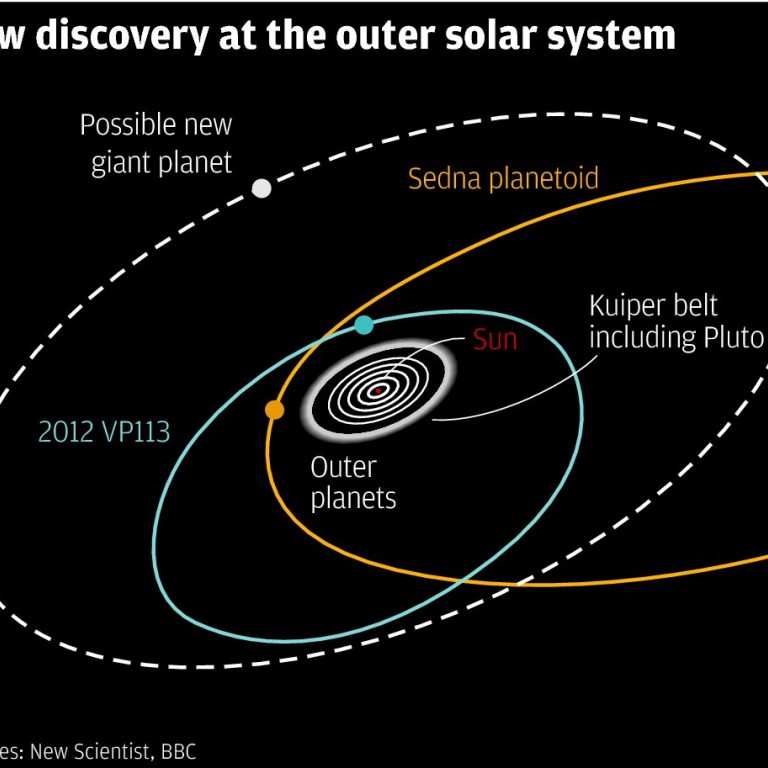
Scientists discover new dwarf planet 2012 VP-113 beyond distant Pluto
Discovery of 2012 VP-113 beyond Pluto might hint at an invisible giant and help us understand early interplanetary movement
Astronomers searching for the faintest glimmers of light beyond distant Pluto say they've discovered a new dwarf planet - and that this planetoid's movements hint that an invisible giant planet perhaps 10 times the size of earth could be lurking around the dark fringes of our solar system.
The stunning discovery of the new dwarf planet 2012 VP-113, described on Wednesday in the journal , helps confirm the existence of an "inner Oort cloud" in an interplanetary no man's land that was once thought to be empty but could potentially be teeming with rocky denizens.
"We had high hopes, and our hopes were confirmed," said Scott Sheppard, an astronomer at the Carnegie Institution for Science who co-wrote the paper with Chadwick Trujillo of the Gemini Observatory in Hawaii.
2012 VP-113 measures about 450 kilometres across and comes to within about 80 astronomical units of the sun, or about 12 billion kilometres. (One astronomical unit is the distance between the earth and the sun.) That's far beyond the Kuiper belt, an icy field of debris that sits beyond Neptune's orbit.
While the dwarf planet is incredibly far out, it's still not far enough to be part of the Oort cloud, a hypothesised cloud of icy debris that surrounds the solar system's disc in a spherical shell that stretches a mind-blowing 5,000 to 100,000 astronomical units from the sun. 2012 VP-113's orbit stretches for a few hundred astronomical units, in what scientists thought was an empty doughnut ring of space between the Oort cloud and the Kuiper belt.
That assumption began to change in 2003 with the discovery of Sedna sitting near the inner edge of this no man's land. Roughly 950 kilometres wide, Sedna is big enough to qualify as a dwarf planet. So scientists were puzzled. Was Sedna a freakish one-off, or was it part of a population of rocky bodies in that supposedly empty area - an inner Oort cloud?
An inner Oort cloud would be valuable to study, scientists said, because these objects were so far away from the gravitational pull of either the planets or the distant stars that they were like a dynamic "fossil" of interplanetary movement in the early solar system.
Sheppard and Trujillo want to look for more Sedna-like objects in this area. If they can find more, they will show that it isn't an anomaly.
Looking for such distant, dim objects is not easy. Unlike the distant stars in the night sky, rocks don't make their own light. So the astronomers have to look for faint, moving glints of reflected sunlight off these distant bodies. That means the sun's rays have to travel all the way out to this dark, cold interplanetary fringe and then come all the way back to us.
The researchers used the Dark Energy Camera (DECam) on the NOAO four-metre telescope in Chile and scanned the sky looking for such dim, slow-moving objects. After months of analysis, the scientists picked up on an intriguing signal in the sky.
"It was the slowest-moving thing I'd seen in the discovery process, so immediately I knew it was interesting," Sheppard said of finding 2012 VP-113. "It was very exciting to know that you've discovered this object that's way out there."
The scientists estimated that there could be about 1,000 objects in the inner Oort cloud with diameters of 1,000 kilometres or more - and some of them could be as large as Mars.
What's more, Sedna and 2012 VP-113 seem to be making their closest approach to the sun at similar angles - which could mean that there's a giant planet out there, tugging at both of their orbits in the same way. This ghost planet could be from one to 20 earth masses, Sheppard said.
"It's not a complete explanation, but it's a possible explanation," said University of California-Los Angeles astronomer David Jewitt, who first discovered Kuiper belt objects and was not involved in the new discovery.
Astronomers will have to find far more of these distant objects and catch enough of them travelling in the same direction before they can say whether a giant planet is lurking in the inner Oort cloud, Jewitt said.
"It isn't watertight," he added, "but it's very, very interesting."
